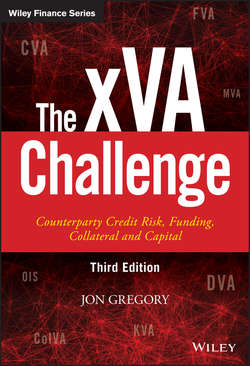The xVA Challenge

Реклама. ООО «ЛитРес», ИНН: 7719571260.
Оглавление
Gregory Jon. The xVA Challenge
Lists of Spreadsheets
Lists of Appendices
Acknowledgements
About the Author
1. Introduction
2. The Global Financial Crisis
2.1 Pre-crisis
2.2 The crisis
2.3 Regulatory reform
2.4 Backlash and criticisms
2.5 A new world
3. The OTC Derivatives Market
3.1 The derivatives market
3.2 Derivative risks
3.3 Risk management of derivatives
4. Counterparty Risk
4.1 Background
4.2 Components
4.3 Control and quantification
4.4 Beyond CVA
4.5 Summary
5. Netting, Close-out and Related Aspects
5.1 Introduction
5.2 Default, netting and close-out
5.3 Multilateral netting and trade compression
5.4 Termination features and resets
5.5 Summary
6. Collateral
6.1 Introduction
6.2 Collateral terms
6.3 Mechanics of collateral
6.4 Collateral and funding
6.5 Collateral usage
6.6 The risks of collateral
6.7 Regulatory collateral requirements
6.8 Converting counterparty risk into funding liquidity risk
6.9 Summary
7. Credit Exposure and Funding
7.1 Credit exposure
7.2 Metrics for exposure
7.3 Factors driving exposure
7.4 The impact of netting and collateral on exposure
7.5 Funding, rehypothecation and segregation
7.6 Summary
8. Capital Requirements and Regulation
8.1 Background to Credit Risk Capital
8.2 Current Exposure Method (CEM)
8.3 The Internal Model Method (IMM)
8.4 Standardised Approach for Counterparty Credit Risk (SA-CCR)
8.5 Comparison of EAD Methods
8.6 Basel III
8.7 CVA Capital Charge
8.8 Other Important Regulatory Requirements
8.9 Summary
9. Counterparty Risk Intermediation
9.1 Introduction
9.2 SPVs, DPCs, CDPCs and monolines147
9.3 Central counterparties
9.4 Summary
10. Quantifying Credit Exposure
10.1 Introduction
10.2 Methods for quantifying credit exposure
10.3 Monte Carlo methodology
10.4 Real-world or risk-neutral
10.5 Model choice
10.6 Examples
10.7 Allocating exposure
10.8 Summary
11. Exposure and the Impact of Collateral
11.1 Overview
11.2 Margin period of risk
11.3 Numerical examples
11.4 Initial margin
11.5 Summary
12. Default Probabilities, Credit Spreads and Funding Costs
12.1 Overview
12.2 Default probability
12.3 Credit curve mapping
12.4 Generic curve construction
12.5 Funding curves and capital costs
12.6 Summary
13. Discounting and Collateral
13.1 Overview
13.2 Discounting
13.3 Beyond perfect collateralisation
13.4 Collateral valuation adjustments
13.5 Summary
14. Credit and Debt Value Adjustments
14.1 Overview
14.2 Credit value adjustment
14.3 Impact of credit assumptions
14.4 CVA allocation and pricing
14.5 CVA with collateral
14.6 Debt value adjustment
14.7 Summary
15. Funding Value Adjustment
15.1 Funding and derivatives
15.2 Funding value adjustment
15.3 The practical use of FVA
15.4 Summary
16. Margin and Capital Value Adjustments
16.1 Overview
16.2 Margin value adjustment
16.3 Capital value adjustment
16.4 Summary
17. Wrong-way Risk
17.1 Overview
17.2 Overview of wrong-way risk
17.3 Quantification of wrong-way risk
17.4 Wrong-way risk modelling approaches
17.5 Summary
18. xVA Management
18.1 Introduction
18.2 The role of an xVA desk
18.3 Hedging xVA
18.4 xVA systems
18.5 Summary
19. xVA Optimisation
19.1 Overview
19.2 Market practice
19.3 Examples
19.4 Costs and the balance of xVA terms
19.5 xVA optimisation
19.6 Summary
20. The Future
Glossary
References
Index
WILEY END USER LICENSE AGREEMENT
Отрывок из книги
To Sylvia, Mimsie, Stella, Cara, Eliza-Joy, Stevie, Peach, Jim, Ginnie, George and Christy
The spreadsheets can be downloaded freely from Jon Gregory's website, www.cvacentral.com, under the counterparty risk section. New examples may be added over time.
.....
It was clear that these now substantial funding costs should be quantified alongside CVA. The cost of funding was named FVA (funding value adjustment) which had the useful effect of consuming the strange DVA accounting requirements (from a bank’s point of view at least). Not surprisingly, the increase in funding costs also naturally led banks to tighten up collateral requirements. However, this created a knock-on effect for typical end-users of derivatives that historically have not been able or willing to enter into collateral agreement for liquidity and operational reasons. Some sovereign entities considered posting collateral, not only to avoid the otherwise large counterparty risk and funding costs levied upon them, but also to avoid the issue that banks hedging their counterparty risk may buy CDS protection on them, driving their credit spread wider and potentially causing borrowing problems. Some such entities posted their own bonds as collateral, solving the funding problems if not the counterparty risk ones. It also became clear that there was hidden value in collateral agreements that should be considered using collateral value adjustment (ColVA). Finally, the dramatic increase in capital requirements led to the consideration of capital value adjustment (KVA) and impending requirements to post initial margin to margin value adjustment (MVA).
Regulation aimed at reducing counterparty risk and therefore CVA was becoming better understood and managed. However, this in turn was driving the increased importance of other components such as DVA, FVA, ColVA, KVA and MVA. CVA, once an only child, had been joined by a twin (DVA) and numerous other relatives. The xVA family was growing and, bizarrely, regulation aimed at making OTC derivatives simpler and safer was driving this growth.
.....